Hybrid material for CO2 reduction paves the way for efficient solar fuels
26th September 2024 -
This novel molecular hybrid material combines copper nanocubes and iron porphyrins to achieve high yields of multi-carbon products for CO2 reduction
Researchers from the Institute of Chemical Research of Catalonia (ICIQ-CERCA), in collaboration with the Max Planck Institute for Chemical Energy Conversion, in Germany, have developed a novel molecular hybrid material for CO2 reduction (CO2R) for the generation of solar fuels and chemical feedstocks.
This new hybrid material, reported in the journal Advanced Energy Materials, combines the capacity of a molecular CO2R catalyst to generate CO with the capacity of Cu(0) materials to achieve C2+ products. This new ternary hybrid material is based on: 1) the Cu2O nanocube catalyst precursor, 2) a covalently anchored and powerful CO2 to CO iron porphyrin and 3) an organic modifier that can additionally fine-tune product formation.
We focused on the generation of multi carbon (C2+) products (e.g., ethylene, ethanol, propanol) in the CO2R reaction since they have high commercial value and energy densities. We designed a new iron porphyrin with high selectivity for CO2 to CO conversion, to connect with Cu catalysts for CO to C2+ conversion by covalent bond. This is a tandem strategy. In addition, the hybrid electrode was further coated with an organic film that regulates the hydrophilicity at the neighbourhood of the active centres. As a result, we successfully produced a potent ternary hybrid material for C2+ production, which paves a possible way towards industrial utilization of CO2.
Zhimei Luo, first author of this work.
The researchers from the groups of Prof. Antoni Llobet and Prof. Feliu Maseras presented a proof of concept of covalent immobilization of a molecular catalyst and organic surface modifiers on Cu-based materials achieving Faradaic efficiencies for theCO2─to─C2+ conversions up to 76% for C2+ products, with 50% being for ethylene, that are among the best reported up to now.
This work highlights the benefits of the rational assembly of molecular catalysts and organic modifiers on Cu-based materials for a synergistic performance. We have demonstrated the ability to bring out the best of both worlds, the molecular and the materials, making them work together for CO2 reduction.
Prof. Antoni Llobet
Hybrid materials for CO2 reduction
The electrochemical reduction of CO2 using renewable energy sources is seen as a promising way to produce valuable chemical feedstocks. A key challenge in this field is finding new catalytic systems that can offer improved activity and selectivity. Copper (Cu)-based materials are recognized as the most active catalysts for producing C2+ products, thanks to their unique ability to go beyond the two-electron reduction of CO2 and facilitate the formation of carbon-carbon (C–C) bonds. Cu has been extensively studied when combined with elements like gold (Au), silver (Ag), or zinc (Zn) for CO production. The catalysts’ composition and morphology can change during operation, complicating the understanding of their catalytic behavior.
In contrast, transition metal complexes have shown promise as robust CO2-to-CO catalysts, offering flexibility through tunable electron density at the metal site and allowing for second sphere coordination effects. Coordination complexes containing porphyrins or phthalocyanines as ligands, combined with different Cu catalysts, have demonstrated the potential to produce C2+ products through tandem catalysis. The successful synchronization between the Cu surfaces and molecular catalysts is essential to achieve a synergistic effects that can be fine-tuned through their interaction via various anchoring strategies.
Reference article
Molecular Hybrid Materials for Selective CO2 Electroreduction to Multicarbon Products
Luo, Z.-M.; Wang, J.-W.; Nikolaou, V.; Garcia-Padilla, E.; Gil-Sepulcre, M.; Benet-Buchholz, J.; Rudiger, O.; Debeer, S.; Maseras, F.; Llobet, A.
Adv. Energy Mater. 2024, DOI: 10.1002/aenm.202402070.
Related news

Let's create a brighter future
Join our team to work with renowned researchers, tackle groundbreaking
projects and contribute to meaningful scientific advancements







 27-03-2025
27-03-2025 



















